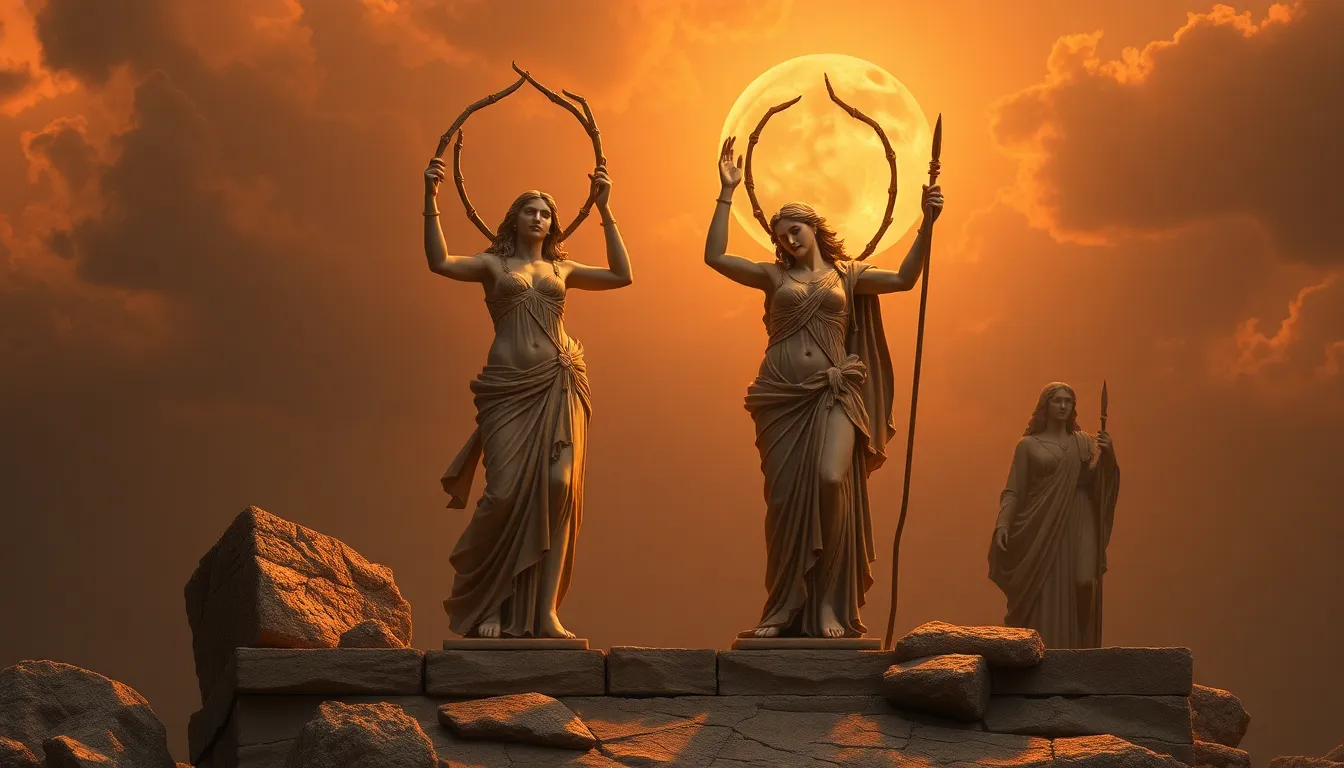The Fates and Their Connection to the Myth of Arachne
I. Introduction
Greek mythology is rich in tales that explore the complexities of human experience, the divine, and the interplay between fate and free will. Among these captivating stories are the Fates, three powerful deities who weave the destinies of all beings. Their influence extends into the myth of Arachne, a mortal whose tale serves as a cautionary narrative about pride and the consequences of challenging the gods.
II. The Fates: Who They Are
The Fates, known in Greek as the Moirai, are personifications of destiny and are comprised of three sisters: Clotho, Lachesis, and Atropos.
- Clotho: The Spinner – She is responsible for spinning the thread of life, symbolizing the beginning of a person’s existence.
- Lachesis: The Allotter – She measures the length of the thread, determining the span of a person’s life and their fate.
- Atropos: The Unchangeable – She cuts the thread, signifying the end of life and the inevitable fate that cannot be altered.
Their roles in weaving the threads of fate highlight the importance of destiny in Greek mythology. The Fates are often depicted as weaving at a loom, reflecting the interconnectedness of all lives and the inescapability of fate.
III. The Myth of Arachne
Arachne was a skilled mortal weaver, renowned for her incredible talent. Her fame led her to challenge Athena, the goddess of wisdom and warfare, to a weaving contest. Arachne’s hubris made her believe that her skills surpassed even those of the goddess.
During the contest, Arachne created a tapestry that depicted the gods in unflattering ways, showcasing their failings and the injustices they imposed on mortals. This act of defiance and pride ultimately led to her downfall, as Athena, enraged by Arachne’s audacity, transformed her into a spider, condemning her to weave for eternity.
The themes of hubris and pride are central to Arachne’s story, illustrating the consequences of challenging divine authority and the tragic fate that befalls those who overstep their bounds.
IV. The Interplay Between the Fates and Arachne
The Fates play a crucial role in Arachne’s destiny, intertwining their influence throughout her narrative. Arachne’s exceptional weaving skills can be seen as a blessing and a curse, as they lead her to challenge Athena, ultimately sealing her fate.
The act of weaving is symbolic in both the Fates’ and Arachne’s stories. For the Fates, weaving signifies the creation of destiny, while for Arachne, it represents her creativity and individuality. However, Arachne’s weaving becomes her downfall, as it defies the order set by the Fates and the gods.
Arachne’s transformation into a spider serves as a reminder of the Fates’ power. She is condemned to weave for eternity, forced to live out a fate that reflects her defiance against divine order.
V. Themes of Creation and Destruction
Arachne’s weaving embodies the duality of creation and destruction. While she creates beautiful tapestries, her challenge to Athena leads to her ruin. This reflects a deeper theme in Greek mythology, where artistic expression can lead to both glory and downfall.
The Fates, as controllers of destiny, embody the destructive power that comes with the manipulation of fate. They enforce the consequences of Arachne’s defiance, demonstrating that even the most talented individuals cannot escape the repercussions of their actions.
Defying divine order, as Arachne did, often results in tragic consequences, underscoring the moral that one must respect the boundaries set by the gods.
VI. Arachne as a Symbol of Human Agency
Arachne’s story raises profound questions about free will versus fate. Her defiance against Athena can be interpreted as an assertion of human agency, a desire to carve out her own identity and destiny.
However, Arachne’s fate ultimately illustrates the limitations of human agency when confronted with the omnipotence of the Fates. Her challenge leads to her transformation and eternal punishment, highlighting the tension between individual creativity and the constraints of destiny.
The relationship between human creativity and the Fates’ control is complex. While Arachne exhibits remarkable skill and creativity, her actions serve as a reminder that such talents must be exercised with humility and respect for the divine.
VII. Cultural Interpretations and Adaptations
The myth of Arachne has been interpreted in various ways throughout history. In classical literature, Arachne is often viewed as a tragic figure whose hubris leads to her downfall.
In art, Arachne’s story has been depicted in numerous paintings and sculptures, often emphasizing the themes of pride and the consequences of challenging the divine. The Fates, too, have been portrayed in literature and art as powerful and sometimes merciless beings, reflecting the inevitability of fate.
Modern adaptations of Arachne’s story continue to resonate today, exploring themes of empowerment, creativity, and the struggle against societal norms. These interpretations often highlight the importance of recognizing one’s limitations and the consequences of overreaching ambition.
VIII. Conclusion
In conclusion, the connection between the Fates and Arachne is a rich tapestry woven with themes of destiny, creativity, and the consequences of pride. Arachne’s story serves as a powerful reminder of the balance between human agency and the inescapable nature of fate.
The lasting impact of these myths lies in their exploration of human experience, reflecting the complexities of free will and the constraints imposed by destiny. Ultimately, Arachne’s tale invites us to reflect on our own lives, the choices we make, and the delicate balance between ambition and humility.




